Listen to this article:
Our life starts and ends with a breath. This natural, yet crucial act is like an invisible thread that we carry throughout our entire existence. And yet, how many times a day do we acknowledge this incredible life-giving force? Still, as some of you might know, there’s a whole practice that revolves entirely around the control of our breath and that is Pranayama. Let’s delve into different types of pranayama, or breathing techniques in detail.
Contents
- 1 What Is Pranayama Breathing?
- 2 The Benefits of Pranayama Breathing
- 3 The 15 Types of Pranayama Breathing
- 4 5. Sheetali Pranayama ‘Cooling Breath’
- 5 6. Ujjayi Pranayama ‘Ocean Breath’
- 5.1 7. Bhramari Pranayama ‘Humming Bee Breath’
- 5.2 8. Bhastrika Pranayama ‘Bellows Breath
- 5.3 9. Kapalabhatti Pranayama ‘Skull Shining Breath’ & ‘Breath Of Fire’
- 5.4 10. Sapt-chakra viloma pranayama
- 5.5 11. Quiet Breathing
- 5.6 12. Rhythmic Breathing /Taalyukt pranayama
- 5.7 13. Tribandha and Pranayama
- 5.8 14. Suryan Bhedan Pranayama (Right Nostril Breathing)
- 6 15. Chandra Bhedan Pranayama (Left Nostril Breathing)
- 7 Final thoughts
What Is Pranayama Breathing?
This ancient practice has its roots in the mystical Indian culture and the word itself derives from Sanskrit, where “prana” means “life energy” and “Yama” is “control”.
This term describes a system of various breathing techniques, that can help us experience a deeper level of connection with our inner selves, and in some cases, it may even allow us to undergo some form of spiritual awakening.
This explains why Pranayama is oftentimes considered a form of meditation. Because our mind, like a glass of cloudy water, when it’s set still can find space for clarity and peace.
As a yoga teacher, when I first started making the first steps onto “my yogic path”, I must admit I was quite skeptical about the real effectiveness of this practice. But when I first tried it, I had an abrupt change of heart because I knew that, from that moment I was completely hooked.
My life started to change completely: I began to feel more at peace, my body felt energized, I started to dethatch from negative emotions and that’s when I came to realize, I was becoming more aware of my true self.
Because believe it or not, Pranayama is not simply a way to control our breath, it’s a precise science that, if used correctly, can allow us to achieve incredible, life-transforming results.
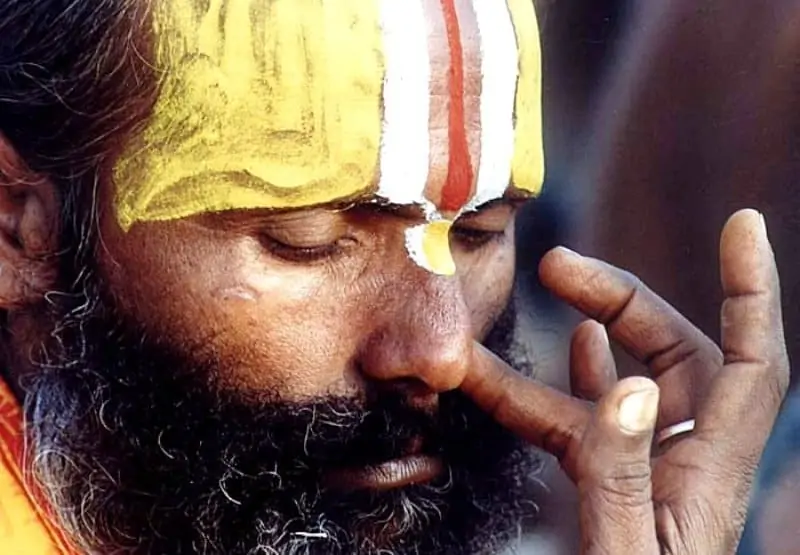
The Benefits of Pranayama Breathing
Some gurus of the past often stated that “the longest our breath is, the longest our life will be”. Being our breath our life force, it goes without saying that when we can control our breath, we gain control over our life itself.
We often get caught up in our hectic life, where a great number of stress factors lead us to experience overwhelming emotions like anger, anxiety, or in worst-case scenarios, depression.
Think about it, when you’re nervous your breath gets irregular, fast-paced. And this, in the long haul, may harm your mental and body health.
But it all changes when you start practicing pranayama exercises. Because when you do, you feel like you’re pressing the “pause” button of your life… And with time you’ll begin to change the way you perceive some thoughts and emotions.
At the same time, on a physical level, when you start using pranayama techniques, the respiratory organs get stronger, and more resistant and some exercise may also improve:
- our circulatory system
- parasympathetic system
- immune system
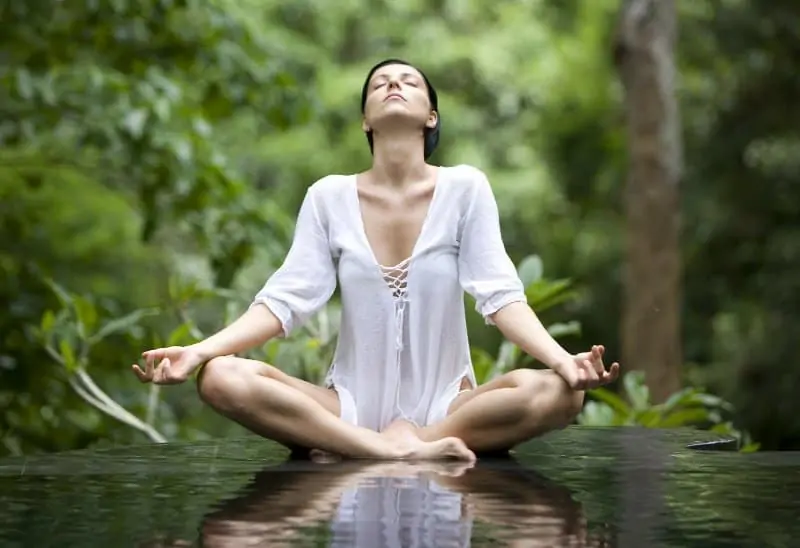
Moreover, each exercise can trigger different effects on our bodies and mind. So that explains why we usually feel calmer and deeply relaxed after some techniques like “Anuloma Vyloma“, while we feel energized, and focused after some other exercises like “Kapalabhatti“.
As a general rule, when performing pranayama, make sure you’re sitting in any comfortable meditation pose and remember to always keep your spine and head in one straight line. Also, try to always practice these exercises on an empty stomach and ensure you’re in a quiet place where you can be undisturbed for a while.
The 15 Types of Pranayama Breathing
1. Dirga Pranayama,’ Three-Part Breath'(aka, full Yogic breath)
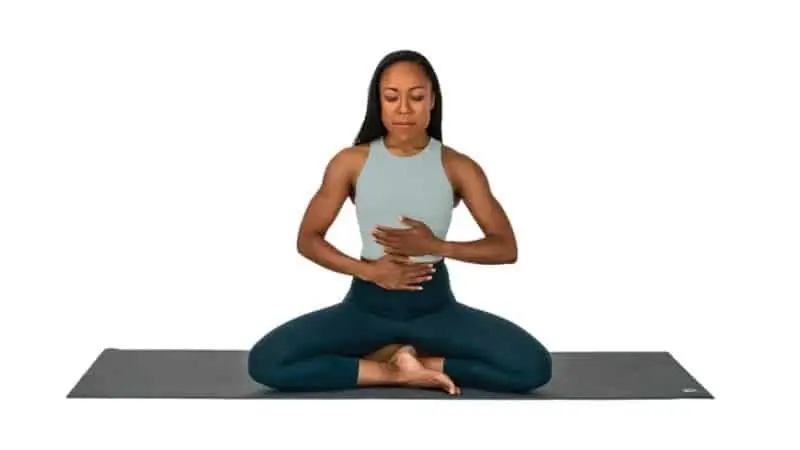
What is it?
This simple yet precise exercise is a combo of three different breathing exercises, where the focus of our attention shifts from the abdominal area to the chest and lastly to the collarbone region.
It has a great range of benefits, just to name a few:
- it elevates the mood by stimulating the endorphins
- relieves stress and anxiety
- increases anti-aging hormones
Precaution:
avoid practicing this exercise when you have nasal inflammation or nasal infections
How to do it?
- Begin to observe the natural in-out flow of your breath
- Place one hand on the belly and one on your chest
- Take a deep inhalation and feel your belly filling up with fresh air.
- Breath even more and begin to feel the expansion of your ribcage
- Feel the breath flow finally reaching the top of your clavicles
- Practice 3 to 5 rounds of full yogic breathing
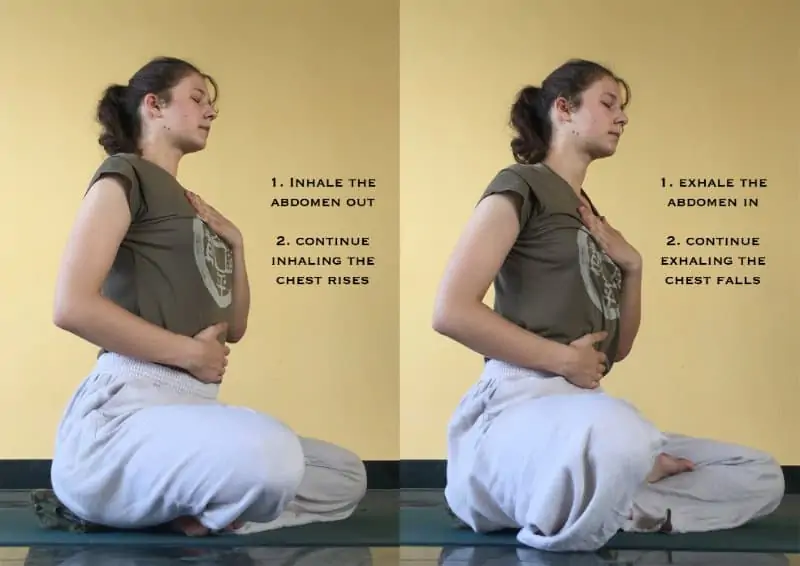
Over time, you’ll start developing a great sense of awareness of the full yogic breath, where the breath flows throughout these three regions harmoniously.
2. Sama Vritti
What is it?
“Sama” is the Sanskrit term for same/ equal while “Vritti” means flow/wave and it’s performed in four different steps (that’s why it’s also known as “square box breathing”). When performing this pranayama, we try to equalize the length of each inhalation and exhalation and it’s a real panacea for both the mind and the body because it allows us to repose in a state of deep, soul-nourishing relaxation.
That’s why this exercise it’s perfect for those moments when we get overwhelmed by stress or whenever we feel disconnected from our body and mind.
How to do it?
Follow four simple steps (the breath count may increase as the practitioner learns to master this technique)
1) Inhale deeply from the nose for at least four seconds
2) Hold your breath for four seconds
3) Exhale for four seconds
4) Hold your breath for four seconds and do it all over again (up to 5 times)

Precaution
Pregnant women and people who suffer from high blood pressure or respiratory issues should avoid practicing breath retention.
3. Nadi Shodhana/Anuloma Vyloma, ‘Alternate Nostril Breathing’
What is it?
The word “Nadi” originates from Sanskrit and translates into “channel” and “Shodhana” means “purification”. Thus, this technique aims to cleanse the Nadis, which according to the ancient Indian medical system, the Ayurveda, are subtle channels where our prana flows.
These channels are tightly interlinked into our mind-body organism and there are three main Nadis: one with strong masculine energy on the right side, called “Pingala”, and on the left side, there’s the feminine Nadi called “Ida” and one in the center called “Sushumna”. Hence when we practice Nadi Shodhana we balance these two different energies into our body.

But there’s more:
-it’s great for almost all imbalances because it purifies and regulates the entire pranic system
-activates the frontal brain and the “Ajna” chakra, improving concentration and peacefulness
-regular practice may help reduce depression
Precaution
-avoid when you have flu or fever
-not suitable for those who suffer from cardiovascular diseases
How to do it?
1) raise the right hand and perform the “Nasagra/Vishnu” mudra

2) close the right nostril with the thumb, breathe slowly and consciously from the left nostril, and count until four (the count can be increased with time).
3) close the left nostril with the ring finger, exhale from the right nostril, and count to six
4) breath in from the same nostril (four seconds), close the right nostril
5) breath out from the left nostril for six seconds and you’ve finished the first round
6) you may repeat the same process up to four times.

4. Viloma Pranayama ‘Against The Wave’
What is it?
Viloma Pranayama is a deeply calming, stress-relieving technique frequently used by practitioners to soothe down anxiety and re-establish order in our emotional landscape
Precaution
As for the majority of the exercises mentioned on this list, it should be strictly avoided by those who suffer from heart disease.

How to do it?
1) inhale slowly and deeply from the nose for two seconds and fill the lungs up to half of their capacity
2) hold your breath for a second and then keep on inhaling for two more seconds, hold your breath and then do this same process until the lungs are completely filled with air
3) exhale and with control from the nose
4) you may repeat the process up to four times
5. Sheetali Pranayama ‘Cooling Breath’

What is it?
The name “Sheetali” comes from Sanskrit and means calm because this exercise can help the practitioner experience a state of peace of mind and tranquillity.
It’s an amazing panacea on warm summer days because it helps us cool down our body while soothing our muscles and nervous system.
Precaution
Not suitable for those who suffer from low blood pressure
How to do it?
1) open your mouth slightly and roll the sides of the tongue up so that it forms a sort of tube
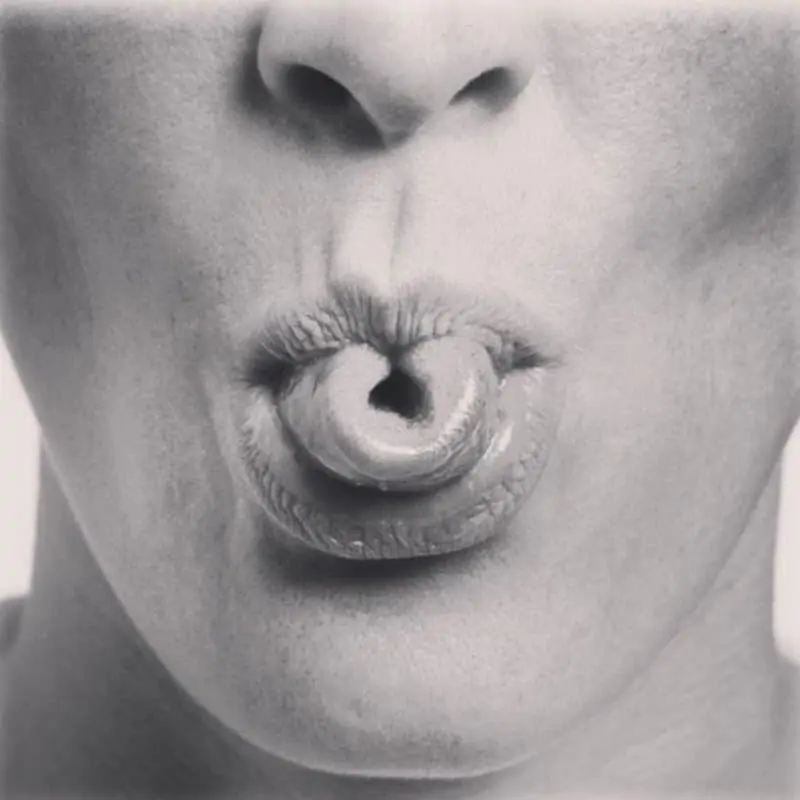
2) breath in from your mouth and when you’ve reached the top of the inhalation close the mouth
3) exhale through the nose
4) repeat the practice as much as needed
6. Ujjayi Pranayama ‘Ocean Breath’

What is it?
This is an extremely powerful breathing technique and as the Sanskrit name suggests (Uj=expand, Jaya=conquest) focuses on the overall expansion of the organs involved in the respiratory process; as a result, “the chest puffs out like a proud conqueror” (BKS Iyengar).
This pranayama aims to generate heat in the body, tapping into vitality and endurance and allowing the practitioner to stay focused and alert.
For this reason, this exercise is commonly used in high-intensity practices such as Vinyasa flow or Ashtanga Vinyasa. Also known as “ocean breath”, given the characteristic sound that it’s generated when performed, which resembles the peaceful sound of the ocean.
Precaution
This exercise should be avoided by those who suffer from heart disease or low blood pressure.
How to do it?
1) try to close your eyes, connect with your breath, and simply sit still to observe your breath gently flowing in and out of your body
2) once your mind and body are settled, take a slow, deep, and steady breath from your nose and fill your lungs while expanding your chest as much as you can
3) shift your awareness to the back of the throat, contract the glottis, and while exhaling from the nose make a hissing, “ha” sound (imagine you’re defogging a mirror in front of your nose)
4) once you’ve reached the bottom of the exhalation you may repeat this process. (try to practice it five to eight times).

7. Bhramari Pranayama ‘Humming Bee Breath’
What is it?
In Sanskrit “brahmar” stands for bee because you’ll notice that when you practice this pranayama you create a low-pitched humming sound, which reminds the typical “buzzing” sound of the bees.
The vibration generated by this sound has an incredibly soothing effect on both body and mind, which makes it ideal for reducing stress, anxiety, anger, and even insomnia!
Furthermore, it might also help our body’s tissues to naturally regenerate and it’s particularly suitable for pregnant women during labour because it leads the practitioner to a deep meditative state.

How to do it?
1) Raise the arms and close the ears with your fingers
2) Inhale through the nose and produce an even and smooth humming sound
3) Exhale from the nose while creating the same sound
4) Repeat up to eleven rounds
8. Bhastrika Pranayama ‘Bellows Breath

What is it?
“Bhastrika” literally translates as bellows because this exercise follows the same dynamic of the blacksmith’s bellows: it creates a series of rhythmic, fast-paced breathing and the diaphragm simulates the movement of a pair of bellows, which blows air, stimulating physical health.
It also improves circulation and flushes out toxins while cleaning the nasal passages and alleviating allergies. Moreover, it also appears to be an amazing help for the lungs, because it rejuvenates and purifies them and it even lets our skin glow!
Precaution
This exercise shouldn’t be practiced by those affected by heart disease, retinal problems, vertigo, hernias, and epilepsy and people with asthma should always perform this practice under the observation of an expert instructor.

How to do it?
1) Start by focusing on relaxing the whole body
2) Raise hands while breathing forcefully from the nose
3) Lower the hands and breathe out with the same intensity from the nose
4) Repeat the same process up to 20 times
9. Kapalabhatti Pranayama ‘Skull Shining Breath’ & ‘Breath Of Fire’
What is it?
This is probably the most powerful and deeply cleansing pranayama. The term itself means “shining skull” because it brings us to a state of light, clarity and sharp focus, which explains why it’s a great remedy for those engaged in mental activities.

Precaution
Avoid this exercise if you suffer from High blood pressure, heart disease, and pregnancy.
How to do it?
1) Exhale forcefully through both nostrils while contracting the abdominal muscles
2) The inhalation is done passively and effortlessly
3) Complete 30 to 60 rounds in a row (make sure you don’t feel too dizzy afterward, so it’d be better to take a break between each round)
4) Return to normal breathing

10. Sapt-chakra viloma pranayama
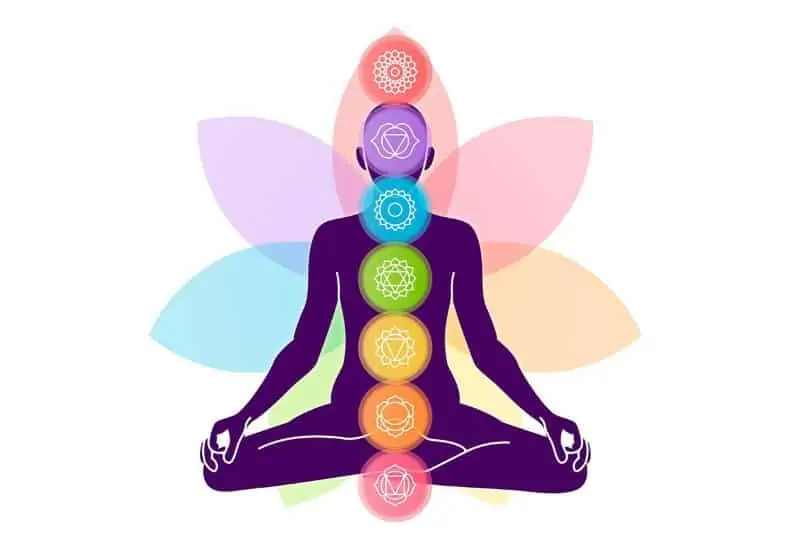
What is it?
This breathing exercise focuses on our energy centers, the chakras, and aims at balancing the different levels of energy of these centers. So this technique follows a sort of meditative flow, shifting the attention from the highest chakra (Sahasrara) to the lowest chakra (Muladhara).
Precaution
Not to be practiced by those who suffer from asthma, chronic heart disease, and respiratory issues.
How to do it?
1) begin in a simple cross-legged pose of your choice
2)practice inhalation in a series of short pauses and focus your attention on each energy center (e.g. focus on the crown chakra inhale-pause and follow a descending order until the bottom)
3) same goes for the exhalation. Start exhaling from the lowest chakra, take a break, and move on to exhaling while focusing on the sacral chakra and so on.
11. Quiet Breathing
What is it?
Commonly used during meditation or after intense asana practice, quiet breathing helps us wind down and keeps us anchored to the present moment.
Its deeply calming effects allow us to slow down the heart rate, reduce blood pressure, and quieten the mind.

How to do it?
1) Start becoming more aware of your breath while sitting in a simple meditative pose or even in a resting pose like Savasana. If you feel comfortable, you may also close your eyes.
2) Observe the flow of your breath and feel how it quietens, slows down its pace, and becomes shallow, little by little
3) Try not to force the breath, the in-out flow should be as natural as possible.
12. Rhythmic Breathing /Taalyukt pranayama
What is it?
This pranayama exercise ( “Taal yukt” literally means=rhythm) is, as the name suggests a rhythmic breathing pattern. This means that in this practice the breath flow follows a steady, precise rhythm without breaks.
If practiced consistently it can increase oxygen supply while resetting the natural rhythm of our body. But it has also great effects on a mental level, as it enhances self-confidence and optimism while gifting us with a beautiful sense of pure calm.

How to do it?
1) Relax the throat and allow the breath to flow freely
2) Inhale slowly and deeply
3) Hold your breath in as long as you feel comfortable
4) Exhale fully
5) Hold your breath out this time
6) Return to a natural, regular breath
13. Tribandha and Pranayama
What is it?
The word “Bandha” means lock and it refers to a specific action that involves a contraction of certain muscles and it’s generally used to tone, cleanse and energize the entire body.
There are three different types of locks, “Jalandhara bandha”, which is a throat lock, “Uddiyana bandha”, the abdominal lock and “Moola bandha”, the perineum lock. All these locks combined form the “Maha bandha” (or Tribandha).

How to do it?
1) Inhale slowly and deeply from your nose and exhale forcefully but with control
2) Hold the breath at the top of the exhalation
3) Push your knees down with your hands
4) Tuck your chin in to perform Jalandhara Bandha
5) Suck the belly in to perform Uddiyana Bandha
6) And simultaneously contract your genital area for Moola Bandha
7) Hold the three bandhas and the breath as much as it feels comfortable
8) Exhale and repeat up to five rounds.

Precaution
Avoid this practice if you’re affected by high blood pressure, if you’re feeling hyperactive, or when on your menstruation.
14. Suryan Bhedan Pranayama (Right Nostril Breathing)
What is it?
“Surya” is the Sanskrit name for the sun and the Surya nadi is connected with the masculine, yang, the aforementioned “Pingala”. Thus, this exercise aims to balance the right “Nadi” while curing heartburn, and fatigue and lowering the body temperature.
Precaution
People who suffer from digestive issues or excess mucus should avoid this practice

How to do it?
1) Perform “nasagra mudra”
2) Close the left nostril with the thumb
3) Breath in slowly through the right nostril
4) Close the right nostril with the ring finger
5) Breath out from the left nostril
15. Chandra Bhedan Pranayama (Left Nostril Breathing)
What is it?
“Chandra” is the Sanskrit name for the moon and Chandra nadi is connected with the feminine energy, intuition, and cooling qualities, the aforementioned “Ida”.
Chandrabhedan Pranayama, also known as the left nostril breathing technique, is a yogic breathing exercise that involves breathing through the left nostril while closing the right nostril.
This practice is believed to have a calming and cooling effect on the mind and body. It also promotes a sense of relaxation, emotional stability, and mental clarity.
Precaution
People who suffer from low blood pressure, severe respiratory conditions, nasal blockages, recent sinus surgery, or vertigo should avoid this practice.
How to do it?
1) Perform “nasagra mudra”
2) Close the right nostril with the thumb
3) Breath in slowly through the left nostril
4) Close the left nostril with the ring finger
5) Breath out from the right nostril
Final thoughts
So I hope this introduction to pranayama can shed more light on this beautiful practice, help you find balance, and peace of mind, and connect you with your inner self. Which are exactly what your mind, body, and soul crave!


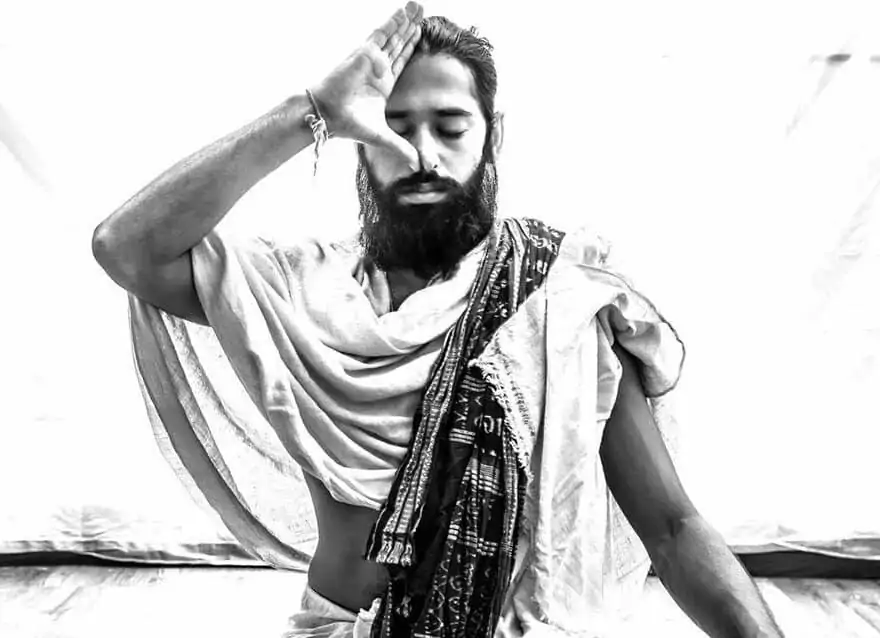
Fantastic introduction! I had no idea there were so many techniques. Thank you.
What is the Sanskrit name for what you are calling “Deep Breathing?” I’m asking, because it says to breathe out of the mouth and I’m not aware of any pranayama when you breathe out of the mouth. I’m only aware of using different types of breath for different effects but all of them are in and out of the nose.
Also Sama Vritti does not have to involve breath retention which is very advanced and not appropriate for most people. It can just be equal inhales and exhales without pauses.
The Sanskrit term for “Deep Breathing” is not commonly used in the context of pranayama practices. Within pranayama, there isn’t a specific practice designated as “deep breathing” since all pranayama techniques inherently entail deep breathing. It’s through pranayama that the life force is said to be enhanced.
Regarding Sama Vritti, also known as the box breath, it typically involves equal counts for inhalation, retention (kumbhaka), exhalation, and another retention, forming a square pattern. It doesn’t necessarily require advanced techniques like breath retention. However, it’s important to note that individuals with certain health conditions, such as pregnancy or respiratory ailments, may need to modify their practice. In such cases, breath retention may not be recommended. Therefore, it’s crucial to understand one’s own body and health needs when practicing yoga or pranayama. Each individual should choose practices that are safe and beneficial for their specific circumstances, as not all practices are suitable for everyone.
Isn’t it the following way?
Surya Bhedan Pranayama –
inhaling through right nostril and exhaling through left nostril.
Chandra Bhedan Pranayama
inhaling through left nostril and exhaling through right nostril.